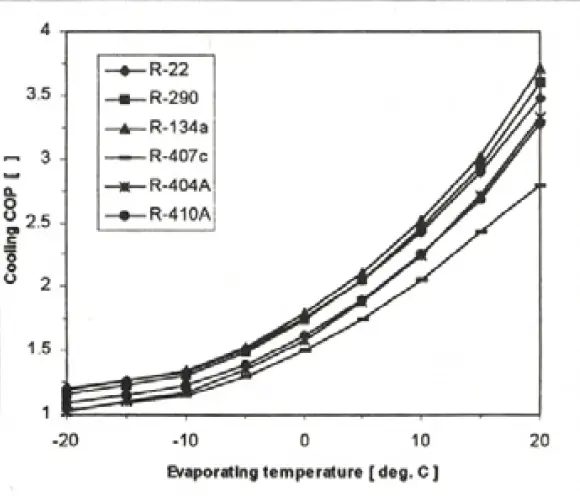Welcome to this post where we’ll embark on an intriguing comparison between the refrigerants R134a and R290. Brace yourselves to uncover the fascinating differences between these two!
- Let’s start by emphasizing that both R290 and R134a are pure gases, capable of being recharged in either liquid or gaseous phase since they are not composed of gas mixtures.
- Propane, or R290, serves as a hydrocarbon refrigerant primarily used in domestic refrigerators, small commercial cooling devices, as well as in low-power air conditioning units and heat pumps. Meanwhile, R134a finds use in equipment of any power range, including domestic and commercial refrigerators, air conditioning chillers for buildings, machine cooling chillers, and automotive air conditioning systems.
- The primary advantage of R290 lies in its low environmental impact and excellent thermodynamic properties, making it increasingly favored in various applications. R290 is ozone-friendly and boasts an impressively low Global Warming Potential (GWP) of only 3.
- On the other hand, R134a also doesn’t harm the ozone layer but has a relatively higher GWP of 1430. As the years pass, this poses challenges due to more stringent environmental restrictions.
- R290 propane carries a safety classification of A3, being non-toxic but extremely flammable. In contrast, R134a is non-toxic and non-flammable.
- Although R290 propane is flammable, the risk is reduced since it is primarily used in cooling circuits with lower cooling capacities, resulting in notably lower quantities of the refrigerant being present.
- Moreover, R290, like other hydrocarbon-type refrigerants, exhibits excellent miscibility with any type of lubricant, although it is recommended to use lubricants with higher viscosity levels. R134a, on the other hand, is compatible with POE oil in conventional refrigeration and PAG oil in automotive air conditioning systems.

- R290 has demonstrated a remarkable reduction in energy consumption in refrigeration systems when compared to R134a.

- Furthermore, it’s crucial to note that R290 and R134a are not interchangeable gases in systems that have already been in operation, unless explicitly authorized by the manufacturer. Using R290 in systems not designed for this gas can lead to instability and adversely affect the compressor’s lifespan.
- DO NOT SUBSTITUTE ONE GAS FOR ANOTHER.
- For instance, for a refrigeration unit operating at -10°C, an absolute pressure of 29.4 psi is obtained from the table. The atmospheric pressure should be subtracted from the table value, for example:
Gauge Pressure = Absolute Pressure – Atmospheric Pressure (14.7 psi)
Gauge Pressure = 29.4 psi – 14.7 psi = 14.7 psi
| °C R134a | °F | bar | psi |
| -30°C | -22°F | 0.84 bar | 12.34 psi |
| -25°C | -13°F | 1.06 bar | 15.58 psi |
| -20°C | -4°F | 1.32 bar | 19.40 psi |
| -15°C | 5°F | 1.63 bar | 23.96 psi |
| -10°C | 14°F | 2 bar | 29.4 psi |
| -5°C | 23°F | 2.42 bar | 35.57 psi |
| 0°C | 32°F | 2.92 bar | 42.92 psi |
| 5°C | 41°F | 3.49 bar | 51.30 psi |
| 10°C | 50°F | 4.14 bar | 60.85 psi |
| 15°C | 59°F | 4.88 bar | 71.73 psi |
| 20°C | 68°F | 5.71 bar | 83.93 psi |
| 25°C | 77°F | 6.65 bar | 97.75 psi |
| 30°C | 86°F | 7.7 bar | 113.19 psi |
| 35°C | 95°F | 8.88 bar | 130.53 psi |
| 40°C | 104°F | 10.18 bar | 149.64 psi |
| 45°C | 113°F | 11.62 bar | 170.81 psi |
| 50°C | 122°F | 13.20 bar | 194.04 psi |
The pressure-temperature charts for R290 (propane) in gauge pressure do NOT REQUIRE CALCULATIONS, as they provide direct values, using an atmospheric pressure reference of 14.7 psi.
| °C | °F | bar |
| -24°C | -11,2°F | 2.11 bar |
| -22°C | -7,6°F | 2.27 bar |
| -20°C | -4°F | 2.44 bar |
| -18°C | -0,4°F | 2.63 bar |
| -16°C | 3,2°F | 2.83 bar |
| -14°C | 6,8°F | 3.02 bar |
| -12°C | 10,4°F | 3.23 bar |
| -10°C | 14°F | 3.45 bar |
| -8°C | 17,6°F | 3.69 bar |
| -6°C | 21,2°F | 3.93 bar |
| -4°C | 24,8°F | 4.19 bar |
| -2°C | 28,4°F | 4.46 bar |
| 0°C | 32°F | 4.74 bar |
| 2°C | 35,6°F | 5.04 bar |
| 4°C | 39,2°F | 5.35 bar |
| 6°C | 42,8°F | 5.67 bar |
| 8°C | 46,4°F | 6.01 bar |
| 10°C | 50°F | 6.36 bar |
| 12°C | 53,6°F | 6.73 bar |
| 14°C | 57,2°F | 7.12 bar |
| 16°C | 60,8°F | 7.52 bar |
| 18°C | 64,4°F | 7.93 bar |
| 20°C | 68°F | 8.36 bar |
| 22°C | 71,6°F | 8.81 bar |
| 24°C | 75,2°F | 9.28 bar |
| 26°C | 78,8°F | 9.76 bar |
| 28°C | 82,4° | 10.27 bar |
| 30°C | 86°F | 10.79 bar |
| 32°C | 89,6°F | 11.33 bar |
| 34°C | 93,2°F | 11.89 bar |
| 36° | 96,8°F | 12.47 bar |
| 38°C | 100,4°F | 13.07 bar |
| 40°C | 104°F | 13.69 bar |
| 42°C | 107,6°F | 14.33 bar |
| 44°C | 111,2°F | 15.00 bar |
| 46°C | 114,8°F | 15.69 bar |
| 48°C | 118,4°F | 16.40 bar |
| 50°C | 122°F | 17.13 bar |
| 52°C | 125,6°F | 17.89 bar |
| °C | °F | psig |
| -24°C | -11,2°F | 31 psi |
| -22°C | -7,6°F | 33.36 psi |
| -20°C | -4°F | 35.86 psi |
| -18°C | -0,4°F | 38.66 psi |
| -16°C | 3,2°F | 41.60 psi |
| -14°C | 6,8°F | 44.39 psi |
| -12°C | 10,4°F | 47.48 psi |
| -10°C | 14°F | 50.71 psi |
| -8°C | 17,6°F | 54.24 psi |
| -6°C | 21,2°F | 57.77 psi |
| -4°C | 24,8°F | 61.59 psi |
| -2°C | 28,4°F | 65.56 psi |
| 0°C | 32°F | 69.678 psi |
| 2°C | 35,6°F | 74.08 psi |
| 4°C | 39,2°F | 78.64 psi |
| 6°C | 42,8°F | 83.34 psi |
| 8°C | 46,4°F | 88.34 psi |
| 10°C | 50°F | 93.49 psi |
| 12°C | 53,6°F | 98.93 psi |
| 14°C | 57,2°F | 104.66 psi |
| 16°C | 60,8°F | 110.54 psi |
| 18°C | 64,4°F | 116.57 psi |
| 20°C | 68°F | 122.89 psi |
| 22°C | 71,6°F | 129.50 psi |
| 24°C | 75,2°F | 136.41 psi |
| 26°C | 78,8°F | 143,47 psi |
| 28°C | 82,4° | 150,96 psi |
| 30°C | 86°F | 158,61 psi |
| 32°C | 89,6°F | 166,55 psi |
| 34°C | 93,2°F | 174,78 psi |
| 36° | 96,8°F | 183,309 psi |
| 38°C | 100,4°F | 192,129 psi |
| 40°C | 104°F | 201,24 psi |
| 42°C | 107,6°F | 210,65 psi |
| 44°C | 111,2°F | 220,5 psi |
| 46°C | 114,8°F | 230,64 psi |
| 48°C | 118,4°F | 241,08 psi |
| 50°C | 122°F | 251,811 psi |
| 52°C | 125,6°F | 262,98 psi |
